Performance Evaluation of Shotcrete Mortar with Silicon Manganese Slag as Substitute for Fine Aggregate
Abstract
1. Introduction
2. Materials and Methods
2.1. Materials
2.2. Preliminary Test
2.3. Mix Proportion
2.4. Test Methods
2.4.1. Air Content Test
2.4.2. Slump Test
2.4.3. Compressive Strength Test
2.4.4. Flexural Strength Test
2.4.5. Splitting Tensile Strength Test
2.4.6. Chloride Ion Penetration Resistance Test
2.4.7. Freezing and Thawing Test
2.4.8. Accelerated Carbonation Resistance Test
2.4.9. Rebound Test
2.4.10. Drying Shrinkage Crack Test
3. Results
3.1. Fresh Properties
3.2. Mechanical Properties
3.3. Durability Properties
3.4. Constructability
4. Discussion
5. Conclusions
- (1)
- The new mix proportions determined from preliminary tests have a water–cement ratio of 40% and a plasticizer content of 0.50% by weight of cement. Additionally, the unit weights of cement and water are 626 kg/m3 and 251 kg/m3, respectively. The total unit weight of aggregates including SiMn slag and fine aggregate is 1462 kg/m3.
- (2)
- Fresh properties of the mortar were assessed by the air content and slump tests. As the SiMn slag replacement ratio increased incrementally from 0% to 100%, the average air content increased from 5.7% to 6.5% and the average slump decreased from 210 mm to 135 mm. The increase in air content and decrease in slump with higher SiMn slag replacement in fresh mortar performance suggest the need for mix adjustments to ensure practical applicability.
- (3)
- Mechanical performances of the mortar were evaluated by the compressive, splitting tensile, and flexural strength tests. As the SiMn slag replacement ratio increased incrementally from 0% to 100%, the average compressive strength at 28 days increased from 24.9 MPa to 35.54 MPa. The splitting tensile and flexural strength at 28 days increased from 2.9 MPa to 4.1 MPa and from 6.25 MPa to 8.55 MPa, respectively. The results suggest that SiMn slag can be effectively utilized to enhance the structural capacity of mortar.
- (4)
- Durability properties of the mortar were evaluated by the tests of chloride ion penetration, freeze–thaw resistance, and accelerated carbonation. As the SiMn slag replacement ratio increased incrementally from 0% to 100%, the chloride ion penetration resistance showed improvement as indicated by the test data of average charge decreasing from 4546 to 3326 coulombs for 28 days. From the freeze–thaw resistance test, the average of relative dynamic modulus of elasticity (RDME) after 300 cycles increased from 88.67% to 91.07%. From the carbonation test, the average carbonation depth decreased from 6.06 mm to 3.86 mm. The improved durability performance demonstrates the potential of SiMn slag for use in shotcrete structures exposed to aggressive environments.
- (5)
- For the evaluation of constructability and serviceability of the mortar, the shotcrete rebound test and 30-day free drying shrinkage test were conducted. The rebound rates of the mortar with 30% and 50% replacement ratios were 51.2% and 18.5%, respectively, but the mortar with other replacement ratios was unsuitable for spraying. From the 30-day free drying shrinkage test, the mortar with a 50% replacement ratio exhibited below 500 micro-strain, satisfying the criterion of 500 micro-strain, whereas the mortar with a 0% replacement ratio exhibited approximately 600 micro-strain. The mortar with 50% SiMn slag replacement showed that SiMn slag can enhance both the efficiency of application and long-term performance in field conditions.
- (6)
- The optimal shotcrete mix for sustainable construction was determined to be a mix consisting of 1462 kg/m3 of fine aggregate with 50% SiMn replacement (731 kg/m3), 626 kg/m3 of Ordinary Portland Cement (ASTM C150 Type I, equivalent to KS L 5201 Type 1), 251 kg/m3 of water, and 3.13 kg/m3 of polycarboxylate-based superplasticizer with air-entraining properties. The findings demonstrate the positive contribution of SiMn slag to the development and utilization of durable and sustainable recycled materials.
Author Contributions
Funding
Institutional Review Board Statement
Informed Consent Statement
Data Availability Statement
Conflicts of Interest
Abbreviations
| SiMn | Silicon Manganese |
| RDME | relative dynamic modulus of elasticity |
References
- Pierrehumbert, R. There is no Plan B for dealing with the climate crisis. Bull. At. Sci. 2019, 75, 6–7. [Google Scholar] [CrossRef]
- Bernardo, G.; Guida, A.; Mecca, I. Advancements in Shotcrete Technology. In Proceedings of the Structural Studies, Repairs and Maintenance of Heritage Architecture XIV, A Coruna, Spain, 13–15 July 2015; WIT Press: Southampton, UK, 2015. [Google Scholar] [CrossRef]
- Ghiasi, V.; Omar, H. Analysis of Shotcrete Lining of Underground Tunnels. Pertanika J. Sci. Technol. 2011, 19, 249–257. [Google Scholar]
- Lackner, R.; Macht, J.; Hellmich, C.; Mang, H.A. Hybrid Method for Analysis of Segmented Shotcrete Tunnel Linings. J. Geotech. Geoenviron. Eng. 2002, 128, 298–308. [Google Scholar] [CrossRef]
- Rispin, M.; Kleven, O.; Dimmock, R.; Myrdal, R. Shotcrete: Early Strength and Re-Entry Revisited—Practices and Technology. In Proceedings of the First International Conference on Underground Mining Technology, Sudbury, ON, Canada, 11–13 October 2017. [Google Scholar] [CrossRef]
- Moon, T.; Wang, E.; Oh, J.; Li, K.; Ramandi, H.L.; Zhang, C.; Saydam, S. Evaluation of Shotcrete Performance from Full-Scale Load-Deflection Tests Using Numerical Analysis. In Proceedings of the ARMA US Rock Mechanics/Geomechanics Symposium, Atlanta, GA, USA, 25–28 June 2023. [Google Scholar] [CrossRef]
- Oreste, P.P. A Procedure for Determining the Reaction Curve of Shotcrete Lining Considering Transient Conditions. Rock Mech. Rock Eng. 2003, 36, 209–236. [Google Scholar] [CrossRef]
- Naseri, S.; Bahrani, N. Design of Initial Shotcrete Lining for a Mine Shaft Using Two-Dimensional Finite Element Models Considering Excavation Advance Rate. Geotech. Geol. Eng. 2021, 39, 4709–4732. [Google Scholar] [CrossRef]
- Bajwa, D.S.; Pourhashem, G.; Ullah, A.H.; Bajwa, S.G. A concise review of current lignin production, applications, products and their environmental impact. Ind. Crop. Prod. 2019, 139, 111526. [Google Scholar] [CrossRef]
- Dong, W.; Kong, F.; He, T.; Liu, M.; Wu, J.; Zhang, L. Enhancing performance and reducing carbon emissions in sprayed concrete using green silica-lignin admixture and recycled aggregates. Low-Carbon Mater. Green Constr. 2024, 2, 28. [Google Scholar] [CrossRef]
- Garba, M.J.; Tian, Y.; Xie, Z.; Yu, C.; Hu, C.; Chen, L.; Yuan, Q. Effect of accelerators on the long-term performance of shotcrete and its improvement strategies: A review. J. Build. Eng. 2024, 89, 109364. [Google Scholar] [CrossRef]
- Chen, L.; Huang, L.; Hua, J.; Chen, Z.; Wei, L.; Osman, A.I.; Fawzy, S.; Rooney, D.W.; Dong, L.; Yap, P.-S. Green construction for low-carbon cities: A review. Environ. Chem. Lett. 2023, 21, 1627–1657. [Google Scholar] [CrossRef]
- Mohanta, N.R.; Murmu, M. Alternative coarse aggregate for sustainable and eco-friendly concrete—A review. J. Build. Eng. 2022, 59, 105079. [Google Scholar] [CrossRef]
- Tayeh, B.A.; Saffar, D.M.A.; Alyousef, R. The Utilization of Recycled Aggregate in High Performance Concrete: A Review. J. Mater. Res. Technol. 2020, 9, 8469–8481. [Google Scholar] [CrossRef]
- Akter, S.; Muniruzzaman, M. Industrial Waste Management and Environment: A Study in Kamrangirchar (Raised Land), Dhaka. Environ. Manag. Sustain. Dev. 2021, 10, 24–44. [Google Scholar] [CrossRef]
- Horii, K.; Tsutsumi, N.; Kitano, Y.; Kato, T. Processing and reusing technologies for steelmaking slag. Nippon. Steel Tech. Rep. 2013, 104, 123–129. [Google Scholar]
- Ma, Y.; Moosavi-Khoonsari, E.; Kero, I.T.; Tranell, G.M. Recycling of Industrial Byproducts in Construction: Metallurgical Slag as a Sustainable Aggregate. Metall. Mater. Trans. B 2018, 49, 2444–2457. [Google Scholar] [CrossRef]
- Olsen, S.E.; Tangstad, M. Silicomanganese production—Process Understanding. In Proceedings of the Infacon X, Cape Town, South Africa, 1–4 February 2004. [Google Scholar]
- Choi, H.B.; Kim, J.M. Properties of silicon manganese slag as an aggregate for concrete depending on cooling conditions. J. Mater. Cycles Waste Manag. 2020, 22, 1067–1080. [Google Scholar] [CrossRef]
- Buruiana, D.L.; Obreja, C.-D.; Herbei, E.E.; Ghisman, V. Re-Use of Silico-Manganese Slag. Sustainability 2021, 13, 11771. [Google Scholar] [CrossRef]
- Ting, J.J.; Low, W.W.; Wong, K.S.; Ting, T.Z.H.; Abdul-Rahman, H. Feasibility of recycling silicomanganese slag as a cementitious material. J. Eng. Technol. Adv. 2023, 8, 97–115. [Google Scholar] [CrossRef]
- Makhambetov, Y.; Myngzhassar, Y.; Abdirashit, A.; Onuralp, Y. Analysis of the silicomanganese market worldwide: A review. Eng. J. Satbayev Univ. 2024, 146, 9–15. [Google Scholar] [CrossRef]
- Saha, A.K.; Khan, M.; Sarker, P.K. Properties of Concrete Incorporating Recycled Materials. Resour. Conserv. Recycl. 2018, 134, 10–24. [Google Scholar] [CrossRef]
- Wong, N.H.; Kong, Z.Y.; Sambo, R.; Chai, C.S.; Khoso, A.R.; Bamgbade, J.A.; Sunarso, J. Physicochemical Characteristics of Silicomanganese Slag as a Recycling Construction Material: An Overview. Min. Metall. Explor. 2024, 41, 1891–1907. [Google Scholar] [CrossRef]
- Patil, A.V.; Pande, A.M. Strength Characteristics of Concrete Using Recycled Aggregates. Adv. Mater. Res. 2011, 255, 3258–3262. [Google Scholar] [CrossRef]
- Nath, S.K.; Randhawa, N.S.; Kumar, S. Environmental Impact of Concrete Incorporating Recycled Materials: A Comparative Study. Resour. Conserv. Recycl. 2022, 176, 105946. [Google Scholar] [CrossRef]
- KS F 2504; Korean Industrial Standard: Standard Test Method for Density and Water Absorption Rate of Fine Aggregates. Korean Standards Association: Seoul, Republic of Korea, 2024.
- KS F 2527; Korean Industrial Standard: Aggregates for Concrete. Korean Standards Association: Seoul, Republic of Korea, 2024.
- KS F 2405; Korean Industrial Standard: Test Method for Compressive Strength of Concrete. Korean Standards Association: Seoul, Republic of Korea, 2020.
- KS L 5201; Korean Industrial Standard: Portland Cement. Korean Standards Association: Seoul, Republic of Korea, 2021.
- KS F 2421; Korean Industrial Standard: Standard Test Method for Air Content of Fresh Concrete by the Pressure Method. Korean Standards Association: Seoul, Republic of Korea, 2016.
- KS F 2402; Korean Industrial Standard: Test Method for Concrete Slump. Korean Standards Association: Seoul, Republic of Korea, 2022.
- KS F 2403; Korean Industrial Standard: Standard Test Method for Making Concrete Specimens. Korean Standards Association: Seoul, Republic of Korea, 2019.
- KS F 2408; Korean Industrial Standard: Standard Test Method for Flexural Strength of Concrete. Korean Standards Association: Seoul, Republic of Korea, 2016.
- KS F 2423; Korean Industrial Standard: Standard Test Method for Splitting Tensile Strength of Concrete. Korean Standards Association: Seoul, Republic of Korea, 2021.
- KS F 2711; Korean Industrial Standard: Standard Test Method for Resistance of Concrete to Chloride Ion Penetration by Electrical Conductance. Korean Standards Association: Seoul, Republic of Korea, 2016.
- KS F 2456; Korean Industrial Standard: Test Method for Resistance of Concrete to Rapid Freezing and Thawing. Korean Standards Association: Seoul, Republic of Korea, 2023.
- KS F 2584; Korean Industrial Standard: Standard Test Method for Accelerated Carbonation of Concrete. Korean Standards Association: Seoul, Republic of Korea, 2016.
- KS F 2595; Korean Industrial Standard: Standard Test Method for Drying Shrinkage Crack in Concrete. Korean Standards Association: Seoul, Republic of Korea, 2021.
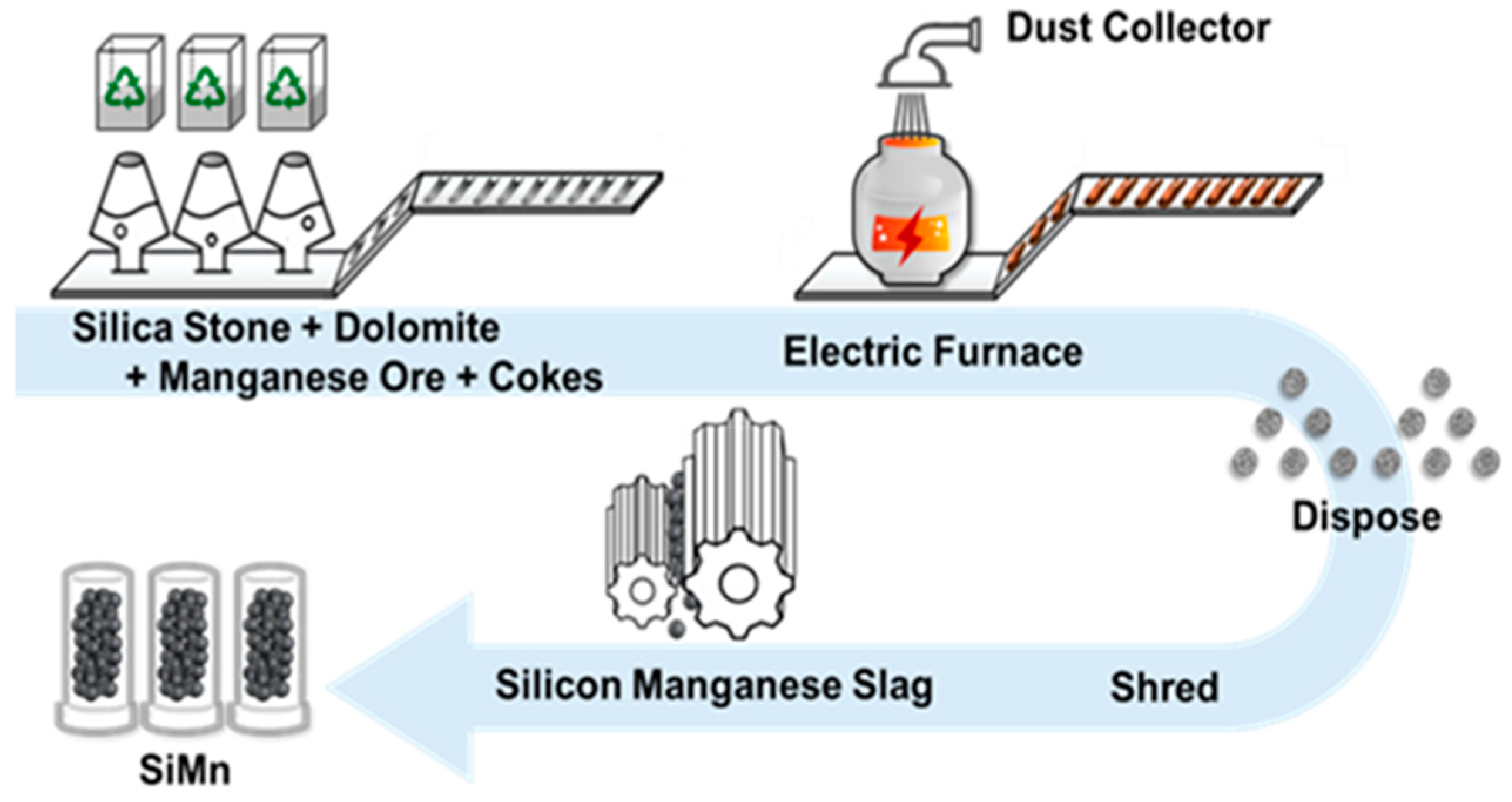
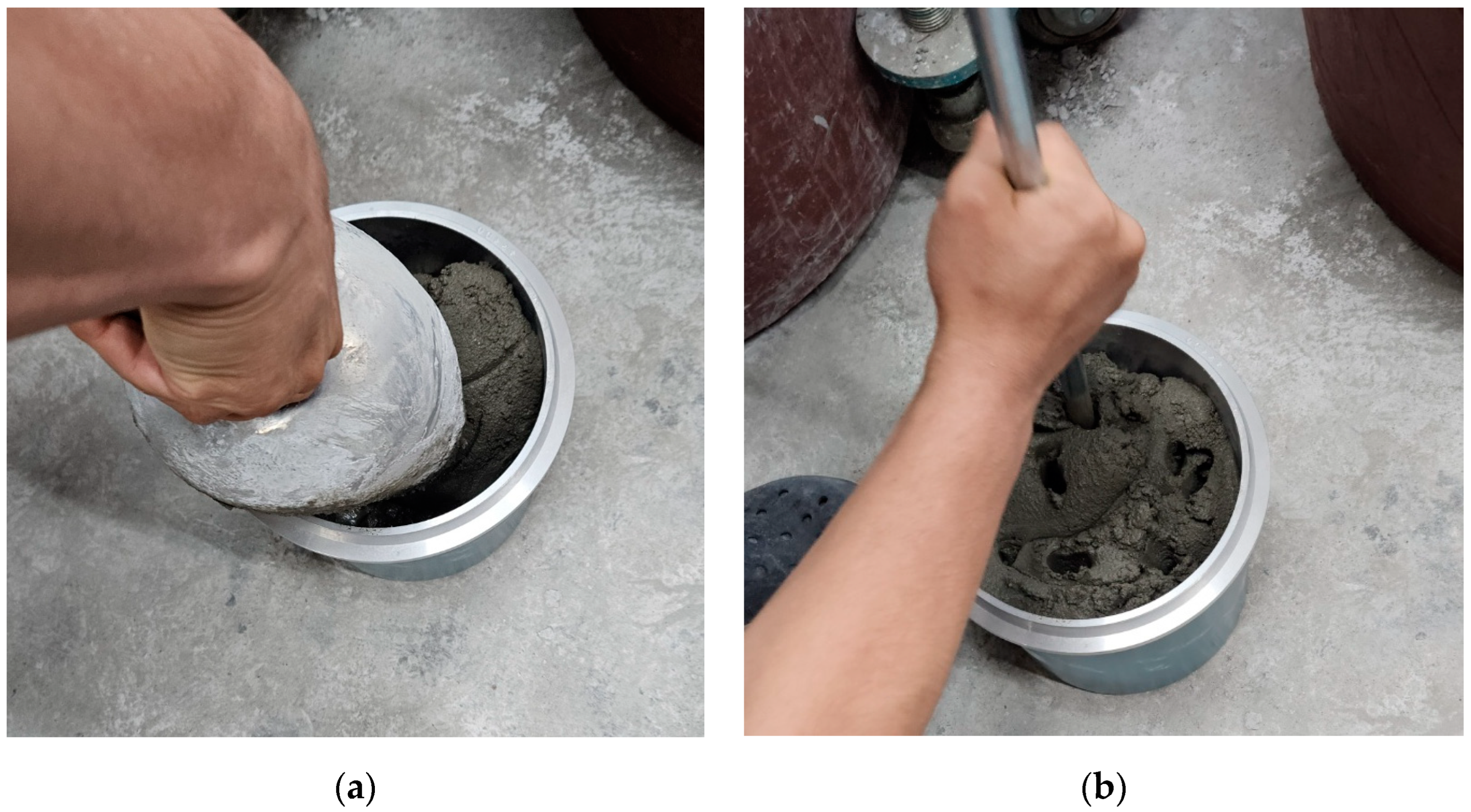
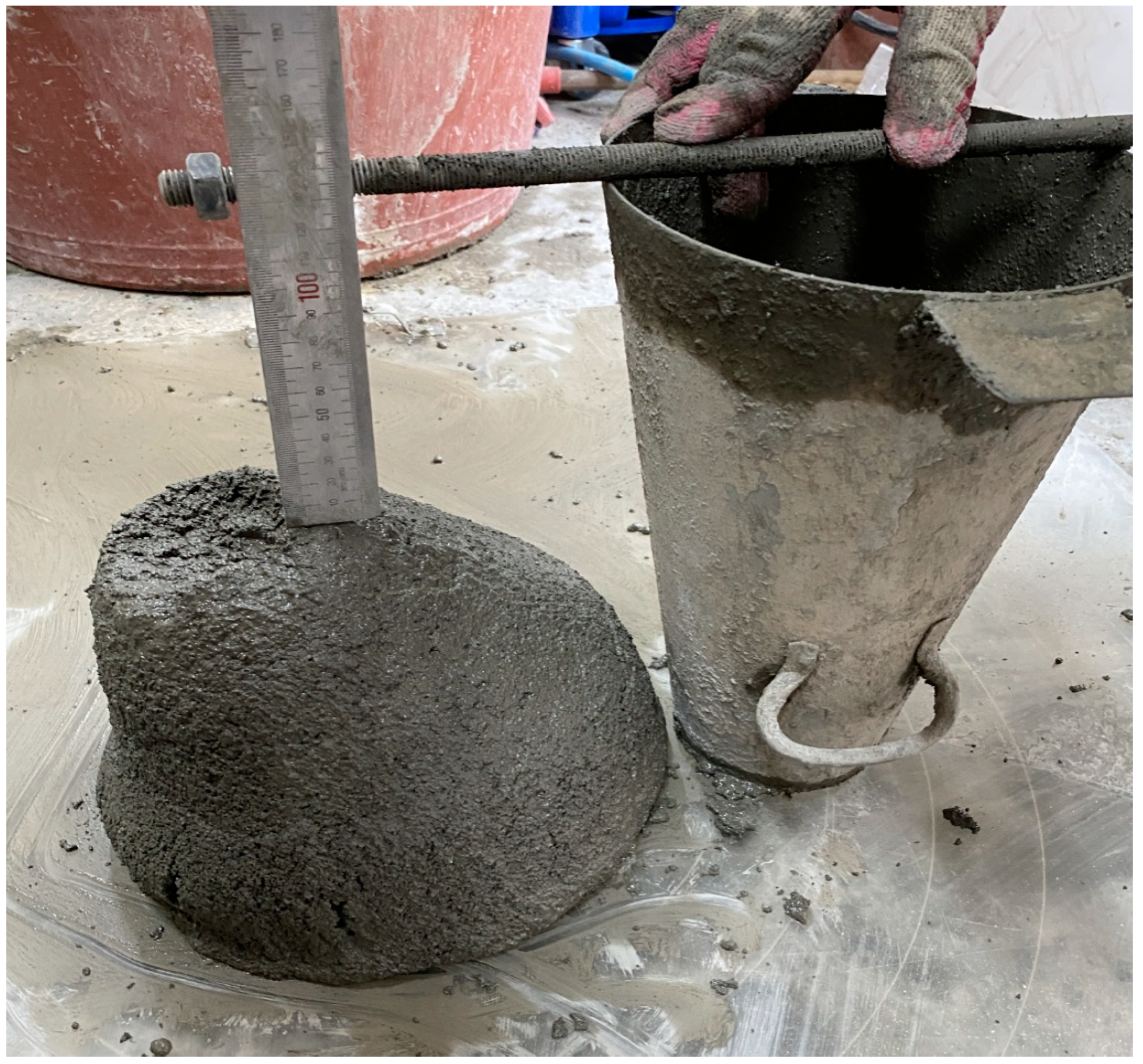
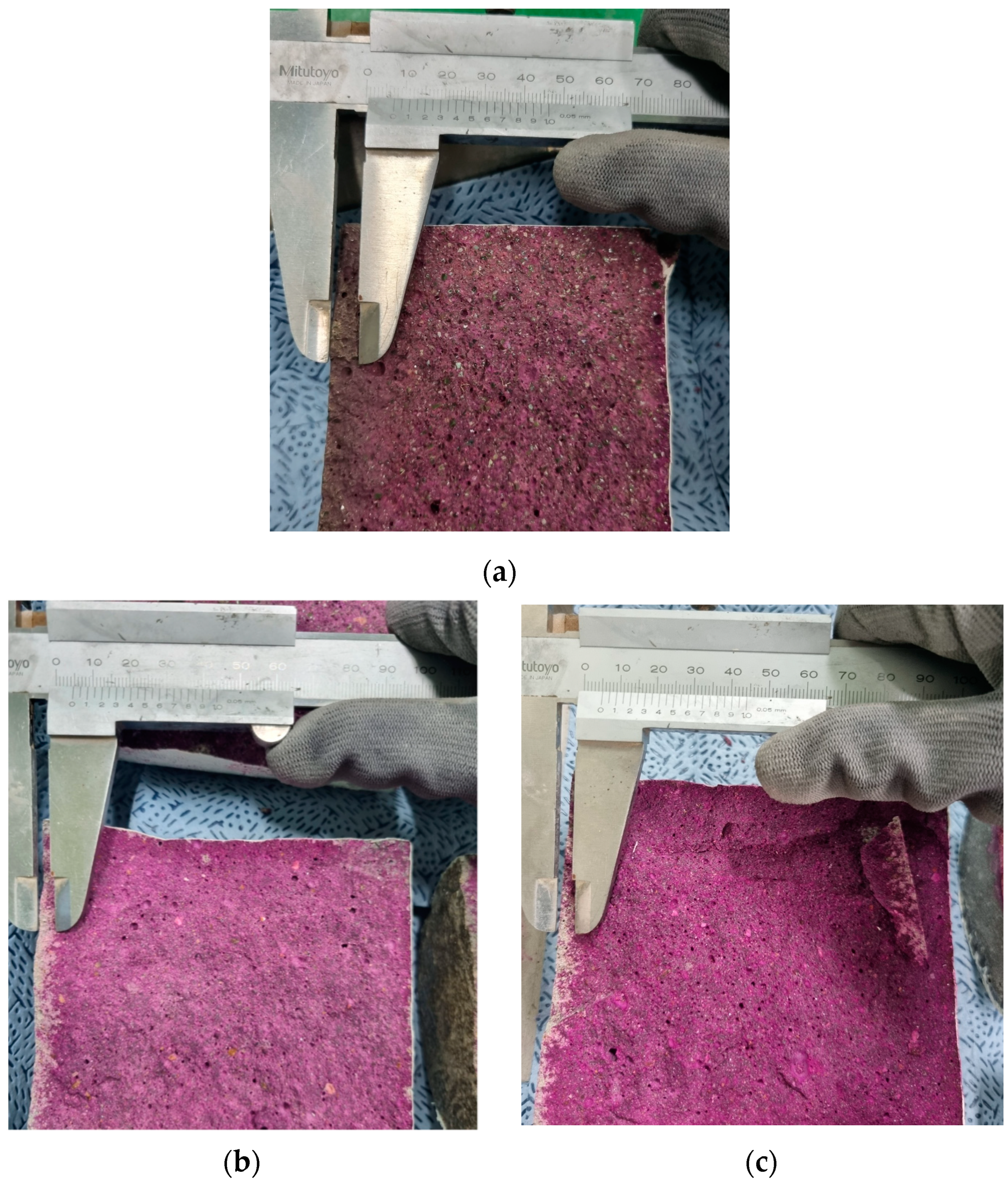
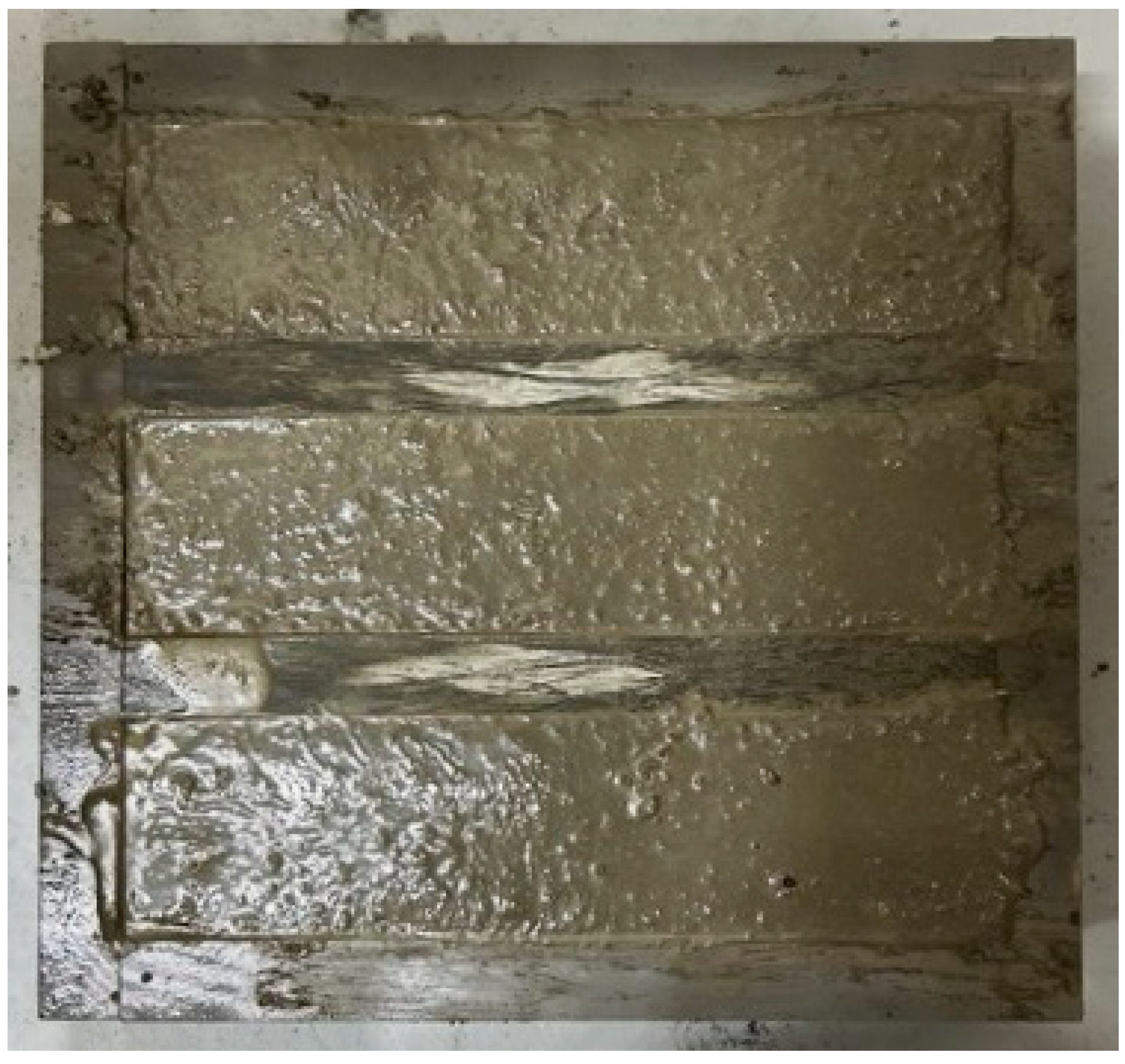

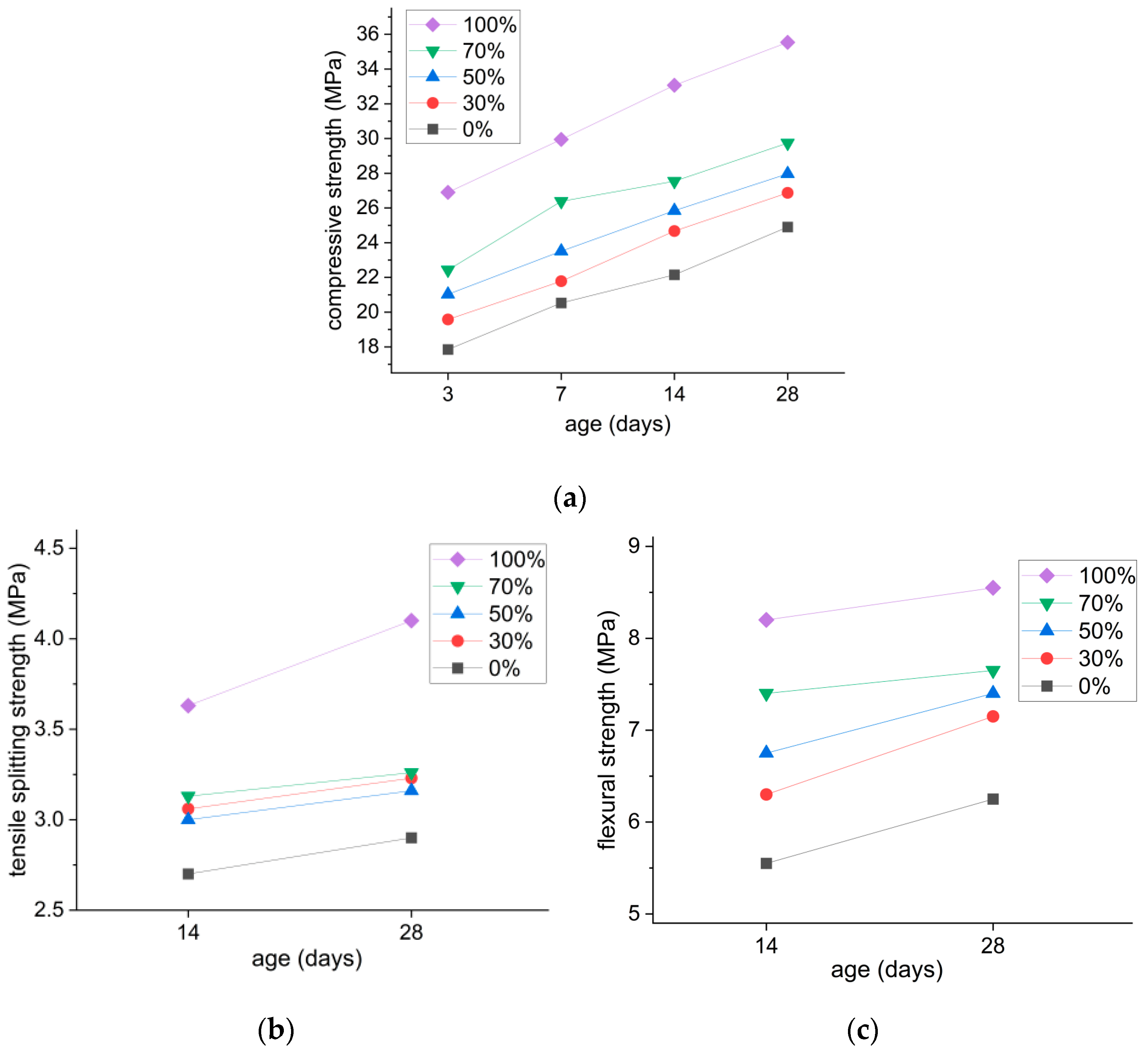


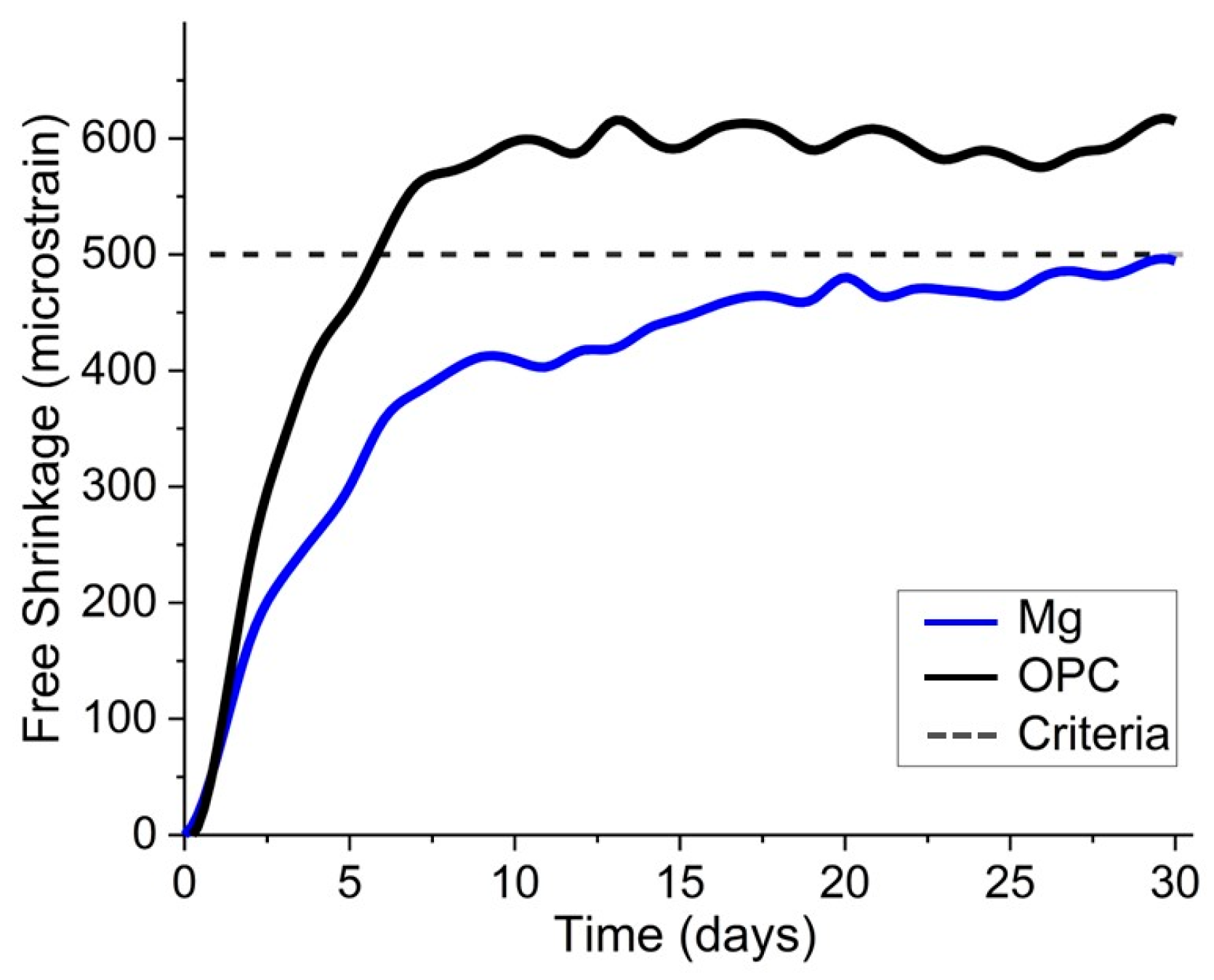
| Item | Unit | Detection Limit | Detection Criterion | Test Result |
|---|---|---|---|---|
| Pb | mg/L | 0.040 | 3 | 0.086 |
| Cu | mg/L | 0.008 | 3 | 0.090 |
| Cd | mg/L | 0.002 | 0.3 | 0.008 |
| Hg | mg/L | 0.0005 | 0.005 | - |
| Cr6+ | mg/L | 0.01 | 1.5 | - |
| CN− | mg/L | 0.01 | 1 | - |
| As | mg/L | 0.004 | 1.5 | - |
| OPC | mg/L | 0.0005 | 1 | - |
| C2HCl3 | mg/L | 0.008 | 0.3 | - |
| C2Cl4 | mg/L | 0.002 | 0.1 | - |
| Cr | mg/L | 0.01 | - | - |
| Property | Unit | Test Result | |
|---|---|---|---|
| Density | Saturated Surface-Dry (SSD) Density | g/cm3 | 3.00 |
| Absolute Dry Density | g/cm3 | 2.97 | |
| Water Absorption | % | 0.79 | |
| Material | SiO2 | Al2O3 | Fe2O3 | CaO | MgO | MnO | NaCl |
|---|---|---|---|---|---|---|---|
| Silicon Manganese Slag | 37.1 | 12.1 | 0.73 | 23.5 | 4.69 | 17.1 | 0.007 |
| Fine Aggregate | 77.2 | 10.2 | 2.87 | 1.12 | 0.65 | 0.09 | 0.008 |
| W/C (%) | Cement (kg/m3) | Water (kg/m3) | SiMn Slag (kg/m3) | Fine Aggregate (kg/m3) | Compressive Strength (MPa) | ||
|---|---|---|---|---|---|---|---|
| 3 Days | 7 Days | 28 Days | |||||
| 30 | 626 | 188 | 1461 | - | 23.35 | 26.24 | 32.1 |
| 35 | 626 | 219 | 1461 | - | 27.8 | 30.7 | 36.8 |
| 40 | 626 | 251 | 1461 | - | 27.14 | 30.1 | 35.8 |
| 45 | 626 | 282 | 1461 | - | 25.2 | 28.2 | 33.1 |
| 50 | 626 | 313 | 1461 | - | 22.48 | 25.23 | 30.4 |
| Plasticizer (C*%) | W/C (%) | Cement (kg/m3) | Water (kg/m3) | SiMn Slag (kg/m3) | Fine Aggregate (kg/m3) | Slump (mm) |
|---|---|---|---|---|---|---|
| 0 | 40 | 626 | 251 | 1461 | - | 5 |
| 0.9 | 40 | 626 | 251 | 1461 | - | FLOW |
| 0.8 | 40 | 626 | 251 | 1461 | - | 27 |
| 0.7 | 40 | 626 | 251 | 1461 | - | 21 |
| 0.6 | 40 | 626 | 251 | 1461 | - | 16 |
| 0.5 | 40 | 626 | 251 | 1461 | - | 13 |
| 0.4 | 40 | 626 | 251 | 1461 | - | 11 |
| 0.3 | 40 | 626 | 251 | 1461 | - | 9 |
| Specimen | W/C (%) | Cement (kg/m3) | Water (kg/m3) | SiMn Slag (kg/m3) | Fine Aggregate (kg/m3) | Plasticizer (C*%) |
|---|---|---|---|---|---|---|
| S-0 (Control) | 40 | 626 | 251 | - | 1462 | 0.50 |
| S-30 | 40 | 626 | 251 | 439 | 1023 | 0.50 |
| S-50 | 40 | 626 | 251 | 731 | 731 | 0.50 |
| S-70 | 40 | 626 | 251 | 1023 | 439 | 0.50 |
| S-100 | 40 | 626 | 251 | 1462 | - | 0.50 |
| Total Passed Charge (Coulombs) | Chloride Ion Permeability |
|---|---|
| >4000 | High |
| 2000–4000 | Moderate |
| 1000–2000 | Low |
| 100–1000 | Very low |
| <100 | Negligible |
| Specimen | SiMn Slag (%) | Fine Aggregate (%) | Air Content (%) | Slump (mm) |
|---|---|---|---|---|
| Control | 0 | 100 | 5.7 | 210 |
| S-30 | 30 | 70 | 6.1 | 205 |
| S-50 | 50 | 50 | 6 | 185 |
| S-70 | 70 | 30 | 6.5 | 160 |
| S-100 | 100 | 0 | 6.5 | 135 |
| Specimen | SiMn Slag (%) | Fine Aggregate (%) | Compressive Strength (MPa) | Splitting Tensile Strength (MPa) | ||||
|---|---|---|---|---|---|---|---|---|
| 3 Days | 7 Days | 14 Days | 28 Days | 14 Days | 28 Days | |||
| Control | 0 | 100 | 17.85 | 20.53 | 22.15 | 24.9 | 2.7 | 2.9 |
| S-30 | 30 | 70 | 19.58 | 21.78 | 24.67 | 26.87 | 3.06 | 3.23 |
| S-50 | 50 | 50 | 21.03 | 23.51 | 25.85 | 27.97 | 3 | 3.16 |
| S-70 | 70 | 30 | 22.43 | 26.38 | 27.54 | 29.74 | 3.13 | 3.26 |
| S-100 | 100 | 0 | 26.9 | 29.95 | 33.07 | 35.54 | 3.63 | 4.1 |
| Specimen | SiMn Slag (%) | Fine Aggregate (%) | Flexural Strength (MPa) | |
|---|---|---|---|---|
| 14 Days | 28 Days | |||
| Control | 0 | 100 | 5.55 | 6.25 |
| S-30 | 30 | 70 | 6.3 | 7.15 |
| S-50 | 50 | 50 | 6.75 | 7.4 |
| S-70 | 70 | 30 | 7.4 | 7.65 |
| S-100 | 100 | 0 | 8.2 | 8.55 |
| Specimen | SiMn Slag (%) | Fine Aggregate (%) | Total Charge Passage (C) | Relative Dynamic Modulus of Elasticity (%) | Carbonation Depth (mm) | |
|---|---|---|---|---|---|---|
| 0 Cycle | 300 Cycles | |||||
| Control | 0 | 100 | 4546 | 100 | 88.67 | 6.06 |
| S-30 | 30 | 70 | 4086 | 100 | 90.36 | 4.45 |
| S-50 | 50 | 50 | 4338 | 100 | 90 | 4.26 |
| S-70 | 70 | 30 | 3667 | 100 | 90.77 | 3.93 |
| S-100 | 100 | 0 | 3326 | 100 | 91.07 | 3.86 |
Disclaimer/Publisher’s Note: The statements, opinions and data contained in all publications are solely those of the individual author(s) and contributor(s) and not of MDPI and/or the editor(s). MDPI and/or the editor(s) disclaim responsibility for any injury to people or property resulting from any ideas, methods, instructions or products referred to in the content. |
© 2025 by the authors. Licensee MDPI, Basel, Switzerland. This article is an open access article distributed under the terms and conditions of the Creative Commons Attribution (CC BY) license (https://creativecommons.org/licenses/by/4.0/).
Share and Cite
Kwon, W.-R.; Lee, J.-B.; Yoon, B.-M.; Kim, J.-H.J. Performance Evaluation of Shotcrete Mortar with Silicon Manganese Slag as Substitute for Fine Aggregate. Materials 2025, 18, 1754. https://doi.org/10.3390/ma18081754
Kwon W-R, Lee J-B, Yoon B-M, Kim J-HJ. Performance Evaluation of Shotcrete Mortar with Silicon Manganese Slag as Substitute for Fine Aggregate. Materials. 2025; 18(8):1754. https://doi.org/10.3390/ma18081754
Chicago/Turabian StyleKwon, Woo-Ri, Jung-Bin Lee, Bok-Mo Yoon, and Jang-Ho Jay Kim. 2025. "Performance Evaluation of Shotcrete Mortar with Silicon Manganese Slag as Substitute for Fine Aggregate" Materials 18, no. 8: 1754. https://doi.org/10.3390/ma18081754
APA StyleKwon, W.-R., Lee, J.-B., Yoon, B.-M., & Kim, J.-H. J. (2025). Performance Evaluation of Shotcrete Mortar with Silicon Manganese Slag as Substitute for Fine Aggregate. Materials, 18(8), 1754. https://doi.org/10.3390/ma18081754









